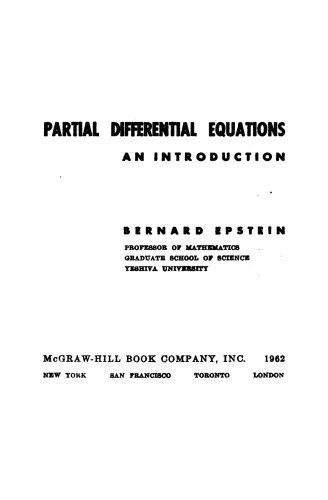Partial Differential Equations: An Introduction.
4.5
Reviews from our users

You Can Ask your questions from this book's AI after Login
Each download or ask from book AI costs 2 points. To earn more free points, please visit the Points Guide Page and complete some valuable actions.Introduction to 'Partial Differential Equations: An Introduction'
Welcome to 'Partial Differential Equations: An Introduction', a comprehensive and thought-provoking book designed for readers who wish to explore the fascinating mathematical world of partial differential equations (PDEs). Whether you are a student, researcher, or an enthusiast of mathematics, this book provides the foundation needed to understand and apply the theory of PDEs to real-world problems. With a focus on mathematical rigor and practical application, this work blends theory and intuition to help you master an essential area of mathematics.
Detailed Summary of the Book
Partial Differential Equations, or PDEs, are mathematical equations that involve multiple independent variables, their partial derivatives, and, most importantly, their interrelationships. This book serves as an introductory yet detailed guide, making it accessible to undergraduate students and a useful reference for advanced learners.
The book begins with an overview of basic concepts, focusing on the fundamental features of partial differential equations and their distinctions from ordinary differential equations. It gradually introduces essential notions like linearity, order, and the importance of boundary and initial conditions. By grounding the reader in these basics, later chapters tackle more sophisticated topics in waves, diffusion phenomena, and potential theory.
Emphasizing practical applications, the book explains how PDEs are foundational to modeling physical phenomena such as heat transfer, fluid dynamics, and electromagnetism. You'll find intuitive explanations alongside rigorous proofs to solidify both conceptual understanding and problem-solving skills. The incorporation of worked examples and exercises at the end of each chapter ensures that readers can effectively engage with theoretical ideas while tackling practical applications.
An important hallmark of this text is its balanced approach to numerical and analytical techniques for solving PDEs. For practitioners, the inclusion of methods like separation of variables, Fourier series, and Green's functions bridges the gap between theory and computation, offering a clear roadmap for modern mathematical modeling.
Key Takeaways
- Understanding the fundamental definitions and classifications of partial differential equations.
- Mastery of classical methods for solving PDEs, such as separation of variables and transform methods.
- A solid grasp of boundary-value problems and their role in physical and engineering contexts.
- Practical insights into analytical versus numerical solutions to PDEs.
- Exposure to real-world applications in physics, economics, and other sciences.
By the time you have completed the book, you will have a toolkit of theoretical understanding and practical methodologies to approach a variety of complex problems involving PDEs.
Famous Quotes from the Book
"Partial differential equations are the mathematics of the physical sciences—we cannot understand the world around us without them, nor can we solve its most pressing problems."
"Mathematics is not just a tool but a language—through PDEs, we speak the language of nature and uncover its patterns."
Why This Book Matters
The study of partial differential equations is central to mathematics, physics, and engineering. PDEs form the mathematical foundation of some of the most important scientific achievements in history: from Maxwell's equations in electromagnetism to the famous Navier-Stokes equations in fluid dynamics. By gaining a solid understanding of PDEs, readers equip themselves with the tools to not only build models of the real world but also solve them effectively.
What sets 'Partial Differential Equations: An Introduction' apart is its clarity of exposition. This book strikes a harmonious balance between rigor and accessibility, making challenging concepts understandable without sacrificing precision. Aspiring mathematicians, engineers, and physicists will find its approach both inspiring and practical.
Furthermore, the book fosters critical thinking, encouraging readers to actively apply mathematical concepts to a range of disciplines, from computational biology to financial modeling. Its lasting significance lies in its ability to empower readers with the critical analytical tools needed to thrive in their academic and professional pursuits.
Free Direct Download
You Can Download this book after Login
Accessing books through legal platforms and public libraries not only supports the rights of authors and publishers but also contributes to the sustainability of reading culture. Before downloading, please take a moment to consider these options.
Find this book on other platforms:
WorldCat helps you find books in libraries worldwide.
See ratings, reviews, and discussions on Goodreads.
Find and buy rare or used books on AbeBooks.
1147
بازدید4.5
امتیاز50
نظر98%
رضایتReviews:
4.5
Based on 0 users review
"کیفیت چاپ عالی بود، خیلی راضیام"
Questions & Answers
Ask questions about this book or help others by answering
No questions yet. Be the first to ask!


